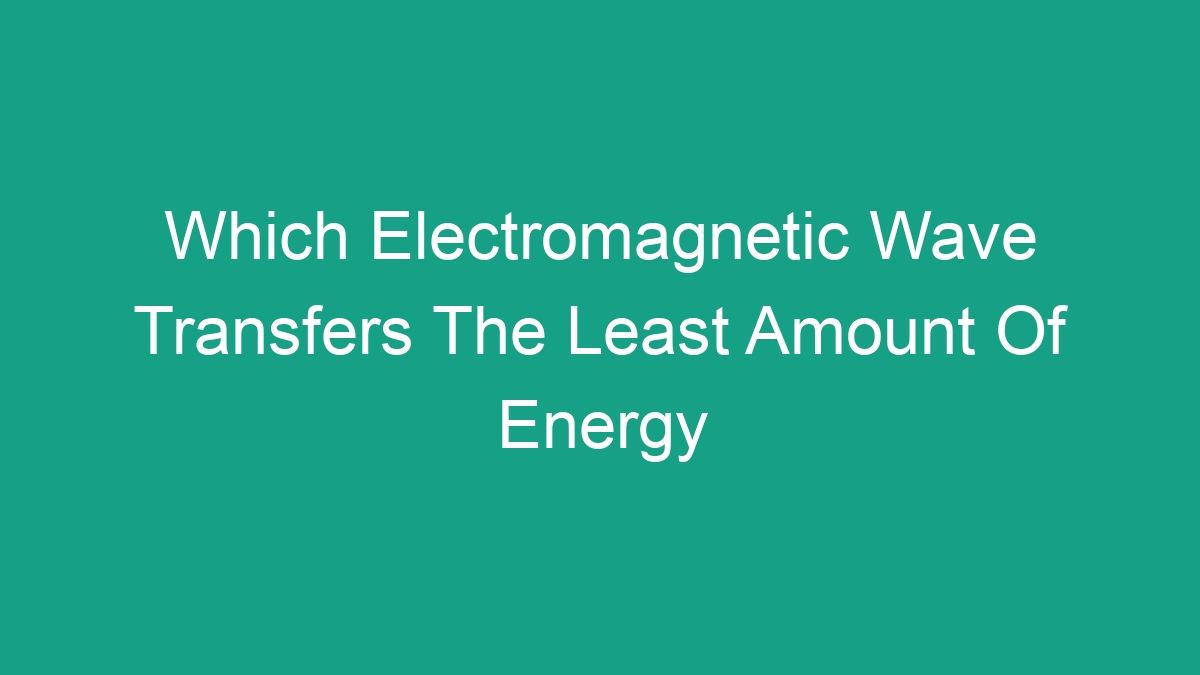
Introduction
Electromagnetic waves are a form of energy waves that are created as a result of vibrations between an electric field and a magnetic field. These waves travel at the speed of light and can be categorized based on their wavelengths and frequencies. The electromagnetic spectrum encompasses a wide range of waves, each with their own unique properties and behaviors. In this article, we will explore which electromagnetic wave transfers the least amount of energy and why it is important to understand this concept.
Understanding Electromagnetic Waves
Before we delve into which electromagnetic wave transfers the least amount of energy, it’s important to have a basic understanding of what electromagnetic waves are and how they behave.
Electromagnetic waves are classified based on their wavelengths and frequencies, and they span from radio waves with the longest wavelengths and lowest frequencies to gamma rays with the shortest wavelengths and highest frequencies. The various types of electromagnetic waves include radio waves, microwaves, infrared radiation, visible light, ultraviolet radiation, X-rays, and gamma rays.
Each type of electromagnetic wave has its own unique characteristics and properties. For instance, radio waves are used for communication and have long wavelengths, while gamma rays are used in medical imaging and have short wavelengths. Understanding the differences between these waves is crucial for various applications, such as telecommunications, medical imaging, and astronomy.
Energy Transfer in Electromagnetic Waves
When it comes to energy transfer, electromagnetic waves play a crucial role in various natural and man-made processes. The amount of energy transferred by electromagnetic waves is directly related to their wavelengths and frequencies. In general, electromagnetic waves with shorter wavelengths and higher frequencies transfer more energy compared to waves with longer wavelengths and lower frequencies.
The energy carried by an electromagnetic wave is directly proportional to the frequency of the wave. This means that higher frequency waves carry more energy, while lower frequency waves carry less energy. The energy of an electromagnetic wave is also inversely proportional to its wavelength, with shorter wavelengths carrying more energy and longer wavelengths carrying less energy.
Which Electromagnetic Wave Transfers The Least Amount Of Energy?
Among the various types of electromagnetic waves, the one that transfers the least amount of energy is radio waves. Radio waves have the longest wavelengths and the lowest frequencies among all types of electromagnetic waves. As a result, they carry the least amount of energy compared to other waves in the electromagnetic spectrum.
Radio waves are used for various purposes, including radio and television broadcasting, communication systems, and radar. Despite their low energy transfer, they are essential for long-distance communication and have numerous practical applications in everyday life.
The low energy transfer of radio waves makes them suitable for long-range communication because they are less likely to be absorbed or scattered by the Earth’s atmosphere. This property also allows them to pass through obstacles such as buildings and walls, making them ideal for wireless communication and broadcasting.
Why Understanding Energy Transfer in Electromagnetic Waves is Important
Understanding the energy transfer of electromagnetic waves is crucial for various scientific, technological, and everyday applications. Here are some reasons why it is important to grasp this concept:
Communications
In the field of telecommunications, understanding the energy transfer of electromagnetic waves is essential for designing efficient and reliable communication systems. Different types of waves are used for different communication purposes, and their energy transfer properties play a crucial role in determining their effectiveness.
For instance, radio waves are used for long-distance communication due to their low energy transfer, while microwaves are used for short-range communication and data transmission due to their higher energy transfer. By understanding the energy transfer of electromagnetic waves, engineers and scientists can optimize communication systems for various applications.
Medical Imaging
In the field of medical imaging, understanding the energy transfer of electromagnetic waves is vital for developing imaging techniques such as X-rays and gamma rays. These high-energy waves are used to visualize structures inside the human body and diagnose various medical conditions. By understanding the energy transfer of these waves, medical professionals can ensure that they use the appropriate amount of energy for imaging without causing harm to the patient.
Environmental Monitoring
Understanding the energy transfer of electromagnetic waves is also important for environmental monitoring and remote sensing. Various types of waves, such as infrared and ultraviolet radiation, are used to monitor environmental conditions, detect pollution, and study changes in the Earth’s atmosphere. By understanding the energy transfer of these waves, scientists can develop effective monitoring systems for assessing environmental changes and addressing global challenges such as climate change.
Conclusion
In conclusion, the energy transfer of electromagnetic waves is directly related to their wavelengths and frequencies. Among all types of electromagnetic waves, radio waves transfer the least amount of energy due to their long wavelengths and low frequencies. Understanding the energy transfer of electromagnetic waves is crucial for various scientific, technological, and everyday applications, ranging from communications and medical imaging to environmental monitoring and beyond. By comprehending this concept, scientists, engineers, and professionals can harness the power of electromagnetic waves for a wide range of purposes and continue to push the boundaries of what is possible with this remarkable form of energy.



